Has the Ark of the Covenant Been Found?
And Noah’s Ark? Pharaoh’s Drowned Army? What About the Garden of Eden?
Originally published in Creation 21, no 2 (March 1999): 10-14.
Adventurers down through history have made spectacular claims about the discovery of all kinds of biblical sites or “holy” relics.
The holy grail, the fabled King Solomon’s Mines, and more recently, Noah’s Ark, the Ark of the Covenant, and many more have featured in fabulous tales of adventure and discovery.
Adolf Hitler was allegedly in possession of what he believed was the “holy lance,” the spear used by the centurion to pierce Christ’s side. This was only one of many relics der Führer obtained (or sought) to satisfy his obsession with the occult. Interestingly, several such “genuine” spears are owned by various collectors around the world.
Not surprisingly, the cup Christ used at His Last Supper, dubbed the “holy grail,” is also simultaneously in the possession of several people at different locations. It has even had a movie based on it: Indiana Jones and the Last Crusade.
Then there are pieces of wood “from the actual cross of Christ.” In the fourth century, Helena, the Roman Emperor Constantine’s mother, made a pilgrimage to the Holy Land. “There with a rapidity and assurance that can only strike wonder in the modern archaeologist, legend has it that she unearthed the True Cross, the lance, the crown of thorns, and identified, under a temple of Aphrodite, the tomb of Christ.”1
Could the garden of Eden ever be found?
The Bible says regarding the location of Eden: “And a river went out of Eden to water the garden; and from thence it was parted, and became into four heads” (Genesis 2:10). Two of these rivers are called Hiddekel (Tigris) and Perath (Euphrates).
This is why many Christians believe that the original garden was located somewhere in the Mesopotamian region (around present day Iraq) where the modern Tigris and Euphrates rivers flow. However, the Bible records a devastating worldwide Flood, many centuries after Adam and Eve were expelled from the Garden. Sedimentary layers, sometimes miles thick, bear mute testimony to this massive watery upheaval which tore apart and buried forever the pre-Flood world.
After the Flood, the survivors moved to the plain of Shinar (Sumeria/Babylonia) which is where we find rivers today called Tigris and Euphrates. These are therefore clearly not the same rivers. They run on top of Flood-deposited layers of rock containing billions of dead things. They were probably named after the original pre-Flood rivers, just as settlers from the British Isles to North America and Australasia applied familiar names to many places in their “new world.”
Note also that the Bible speaks of one river breaking into four, only two of which were called Tigris and Euphrates. This is not what is found in the Middle East today.
The Garden’s actual location on the globe can never be established—maybe it was where we now find the middle of the Pacific Ocean!
This cross became an object of pilgrimage, with pieces cut off as a token for the one who made a generous offering. Theologian John Calvin (1509–1564) wrote that, by his day, there were so many parts of the “true cross” around that “whereas the original cross could be carried by one man, it would take three hundred men to support the weight of the existing fragments of it.”2
Similar “amazing discoveries” are still announced today. Sometimes they are based on ignorance (or rejection) of Scripture. For example, it was recently claimed in a Time-Life documentary that the site of the Garden of Eden had been found—but see the box titled "Amazing Claims" below.3
Such a staggeringly impressive list would mean that Ron Wyatt had been almost as miraculously assisted by God as the patriarch Moses.
In the case of other recent “discoveries,” however, the would-be Indiana Joneses are very familiar with the Bible. Perhaps the most well-known are the claims of one Ron Wyatt, from Tennessee, heavily promoted also by a Jonathan Gray, from South Australia.
The Wyatt/Gray claims are truly astonishing (see Amazing claims). Unfortunately, reputable Bible-believing archaeologists and other experts willing and capable of giving an objective assessment are never able to check out the claimed artifacts. There is generally a plausible-sounding story as to why that is impossible, or why the time is not right. The alleged finding of the Ark of the Covenant (see also The Ark of the Covenant—could it even be found?) is associated with claims of supernatural intervention, photographs mysteriously getting fogged or vanishing, and “Men in Black” style government cover-ups.
Are the claims true? If they are, such a staggeringly impressive list would mean that Ron Wyatt had been almost as miraculously assisted by God as the patriarch Moses.4 If, however, a careful examination of just one or two of these claims reveals them to be false, fanciful or fraudulent, the “divine leading” option evaporates, and it is clear that Christians are being seriously misled.
The non-Ark site

Well-known creationist geophysicist Dr John Baumgardner, a scientist at Los Alamos Laboratories respected for his work on plate tectonics. He is known for his strong stand on the truth of Genesis. He researched the “Ark-site” with Wyatt and eventually concluded the claims were “bogus.”
Back in 1992, Wyatt’s “Noah’s Ark” claim (see This is not the Ark of Noah) was subject to a thorough investigative exposé in this magazine (see online version).5 The 13-page report told of how this ministry had checked the claims, even ringing the lab staff that had done the analyses, for instance. Sadly, though we would have been delighted if this really were the Ark, we found almost all the specific claims to be untrue and/or misleading.
The results of detailed analysis of this site, including mapping, magnetometer surveys,6 drill-core sampling, and more, enable any geologist to be able to diagnose with certainty the exact nature of this geological object.7
The “discoverers” have since produced a rebuttal, convincing only to those who have misunderstood or not carefully read our article. They quote as support the well-known creationist scientist Dr John Baumgardner (right), but in fact he long ago decided that this “find” was a geological formation. They also appeal to the late marine engineer David Fasold. Fasold, who had repeatedly rejected biblical authority, did originally think it was a boat, but towards his life’s end co-authored an article in a geology journal supporting its true nature.8
When questioned about Baumgardner’s retraction, Wyatt has claimed that it was made for fear of losing his job. Yet Baumgardner has been known as a “full-on” creationist in his job and community for years, and had no difficulty agreeing to our publishing an interview with him in 1997. At that time, he told us that Wyatt’s claims about himself were as “bogus” as Wyatt’s claims about the “Ark site.”9
Sodom and Gomorrah?
The remnants of Sodom and Gomorrah? The “discoverers” featured in our article have persuaded a number of people unfamiliar with basic geology that the larger picture at left is the city of Gomorrah, above middle is a “ziggurat,” and the right image a “sphinx.” However, the truth is less spectacular. In this Dead Sea area (near Masada), there are many soft, evaporite deposits like this, which can easily be shaped by the action of wind and rain. Not only has on-site geological analysis shown this to be the case—lab testing of alleged “ash” samples (see below) definitively confirms that these are not “burnt buildings” (see main text).
| Mineral | Sample 1 | Sample 2 |
|---|---|---|
| Gypsum | 5 | 99 |
| Sulfur | — | — |
| Aragonite | 60 | — |
| Calcite | 3 | — |
| Dolomite | 1 | — |
| Quartz | 3 | 0.5 |
| Plagioclase | 1 | — |
| K-feldspar | 1 | — |
| Unidentified clay | 25 | — |
| Halite | 1 | — |
| TOTAL | 100 | 100 |
Answers in Genesis did not attempt to involve itself in checking any of the other claims, but someone who had been with Wyatt to his “Sodom and Gomorrah” site10 sent us samples he had from there of the alleged ash from a couple of the “buildings,” and a sulfur ball.11 The photos show the structures at “Sodom and Gomorrah,” together with the labels put on them by Wyatt. Simple visual inspection of such photos (and watching videos put out by these “amazing discoverers”) strongly suggests that these “building ruins” are soft sedimentary structures with some lamination, carved into an array of shapes by rain and wind.
To put it mildly, the claim that such structures would form from incinerated buildings, then survive in the open for thousands of years, defies understanding of basic scientific principles (not to mention common sense).
Nevertheless, we sent the samples for chemical analysis to a reputable Australian laboratory.12 Their report was interpreted by a Ph.D. geochemist.13 The existence of the sulfur ball is not surprising—the entire area is rich in natural sulfur. The results from the “ash” (see chart below, right) were not consistent with what would be expected from incinerated ancient buildings, or rock ash of any sort. Instead, they clearly indicated an [evaporite] deposit of gypsum-type minerals. This crumbly, easily eroded material fully explains the visual impressions, and is consistent with the known features of this area. The chemistry also shows an abundance of carbonates, which would be broken down by heat.14
Pharaoh’s chariots?
Some unsolicited evidence also came our way concerning the alleged chariot wheels of the Exodus (which have never been made available to any archaeologists, Bible-believing or otherwise). There is a Jonathan Gray video purporting to show these on the bottom of the Red Sea. In one part, Gray claims that a “British Admiralty chart” he is holding shows a “sand bridge” with great depths either side.
The hydrographic office of the UK Ministry of Defense is, by international agreement, the authority for charting the Red Sea. A Mrs M. H. sent them the video; they wrote back to her that:
-
Gray’s chart could be positively identified on blowups as United States chart no. 62020.
-
“Contrary to Mr Gray’s statement, the ‘sand bridge’ is not now, and never has been, a recognizable feature on British Admiralty Charts. Nor is it recognizable on the U.S. chart held by Mr Gray.”
-
Gray’s comments about the “great depths” also mislead.
-
The naturally lit video footage of the sea floor could not possibly have been filmed anywhere near the spot claimed by Gray, as insufficient light would penetrate at that depth.
Subsequently, Gray published a second letter from the same office, claiming it vindicated his claims of a “sand bridge.” However, when we checked with them, they wrote that their comments had been “seriously edited,” with “selected parts” shown under their letterhead. The full letter, which they sent us, “does not confirm the existence of a ‘sand bridge.””
In short, whenever we have had the opportunity to objectively assess any of these claims, the same pattern emerges as from our “Ark” investigation.
In Closing
There is little doubt that the genuine discovery of certain objects would be both exciting and a powerful witness to the truth of the biblical record. However, we need to be careful not to become like some medieval pilgrims, keen to have relics to supplement (or supplant) the worship of the living God. Christ actually taught that if people did not listen to “Moses and the prophets,” then neither would something as spectacular as someone rising from the dead convince them (Luke 16).
No doubt such fanciful claims as discussed here will always be with us, made by those seeking either profit, fame, the fulfillment of some deep psychological needs, or any combination of these. The “discoverers” will often appear completely sincere, saying all the “right Christian things.” Perhaps at some point they have even persuaded themselves.
The Bible does not say we should “believe all things,”
but rather that we should “prove all things
” ({% scripture "1
Thessalonians 5:21" %}). Neither does it encourage a gullible approach
toward those claiming the name of Christ. Rather, it warns about wolves
among the flock, and also teaches that the heart of man is deceitful and
depraved (Jeremiah 17:9).
As in other areas, extraordinary claims carry an extraordinary burden of proof. There is already a huge amount of archaeological and other evidence consistent with the truth of the Bible. Bible-believing experts exist in many fields, such as the archaeologist author of our article on Jericho (The Walls of Jericho). They are always glad to assess and publicize actual evidence of genuine finds (there have been many over the years) supporting the historicity of the Bible.
Amazing claims
Ron Wyatt has claimed, among other things, to have discovered the following:
- The Ark of the Covenant.
- Chariot wheels and other relics from Pharaoh’s drowned army at the bottom of the Red Sea.
- The real Sodom and Gomorrah, with building outlines still standing as piles of sulfur-fried ash.
- Noah’s Ark.
- The real Mt Sinai.15
- The rock at Horeb.
- The true site of Korah’s earthquake.
- Noah’s house, and the graves of Mr and Mrs Noah, together with millions worth of her jewelry (allegedly then stolen from Wyatt).
- The real site of the crucifixion, apparently above the cave containing the Ark of the Covenant, so that Christ’s blood would drip on to the Mercy Seat.
- An actual sample of Christ’s blood, with chromosomes allegedly still visible under the microscope, showing that there was no human father. Placed in growth medium, the cells began dividing, says Ron.
- The tablets of the Ten Commandments, bound by golden hinges.16 Return to text.
 The
Ark of the Covenant—could it even be found?
The
Ark of the Covenant—could it even be found?
The Wyatt/Gray “track record” of false claims on other subjects (see main text) makes it easy to dismiss these current claimants to finding the Ark of the Covenant, along with all their “reasons” as to why no one is conveniently allowed to access any hard evidence.
The Ark was probably lost or destroyed when the Babylonians sacked Jerusalem in 587 B.C. and destroyed the temple. If Jews had hidden it, the Ark would surely have been used in the Second Temple, which Josephus says it wasn’t (Jewish Wars 5:219).
An additional reason for skepticism, which would apply to any future such claims by others, relates to God’s dealings in fulfilling the Old Covenant system via the New Covenant in Christ. God forcefully demonstrated this with the destruction of the Jerusalem temple in AD 70, predicted by Christ four decades earlier (Matthew 24). There were to be no more animal sacrifices once His designated “Passover Lamb,” the Lord Jesus Christ (John 1:29, Rev. 13:8), had been slain “once for all” (Hebrews 10:10).
Jeremiah 3:16 strongly suggests that there is to be no reappearance of the Ark of the Covenant, either: “And it shall come to pass, when ye be multiplied and increased in the land, in those days, saith the LORD, they shall say no more, The ark of the covenant of the LORD: neither shall it come to mind: neither shall they remember it; neither shall they visit it; neither shall that be done any more.” Return to text.
 This is not the Ark of Noah
This is not the Ark of Noah
Many people have seen photographs similar to these, depicting what some continue to claim is the remains of Noah’s ark. However, this is an unusual, though natural, geologic formation.
A thorough investigation of evidence from the site, along with the eyewitness testimony of Bible-believing scientists who have been there, confirms this conclusion.
Has the Ark, or some of it, survived the ravages of time in some form? Tantalizing clues and alleged eyewitness accounts from locations on greater Mt Ararat are available. However, to date, all efforts to find any definite hard evidence to confirm them have failed. Creation magazine will report reliably on this issue, so you will know if and when God should permit such an important find. Return to text.
Footnotes
- National Geographic, 164 (6):723, December 1983.
- John Calvin, Book of Days, Volume 1, p. 587.
- Time-Life Video and Television Production, Lost civilizations: Mesopotamia, Return to Eden, 1995.
- E.g. Wyatt tells that in response to his prayer, an earthquake opened, then seamlessly closed the alleged Noah’s Ark site to allow him to look at its “petrified timbers.” He has also claimed the divine gift of deciphering various ancient writings without any training.
- A. Snelling, Special Report: Amazing “Ark” Exposé, Creation 14(4):26–38, 1992.
- This was to test the assertion of regular metallic readings—this is an extremely sensitive instrument.
- The formation is even crosscut by an obvious layer of fossil-bearing (Flood deposited) limestone; this alone eliminates any possibility that it is what Wyatt et al claim. The Wyatt claims appear to have misled some sincere Christians into repeating them.
- D.F. Fasold, “Bogus ‘Noah’s Ark’ from Turkey exposed as a common geologic structure,” Journal of Geoscience Education 44:439–444, 1996.
- See interview with Dr John Baumgardner, Creation 19(3):40–43, 1997. Several other creationists and organizations have also been vilified, subtly or otherwise, after speaking the truth about this matter.
- The person who provided the samples was at that time favorably disposed to the claims.
- These occur naturally at various localities.
- Amdel Laboratories Ltd., South Australia.
- Dr Clyde Webster, of the Adventist Geoscience Research Institute in the US.
- This is the principle on which many dry powder fire extinguishers work. The heated carbonate releases CO2, smothering the fire.
- The mountain called “Sinai” today does not fit well with the biblical data—no less than eight sites have been proposed over the years.
- An avid disciple of Gray/Wyatt in South Australia told Answers in Genesis of a phone call from Ron Wyatt confirming that he had the Ten Commandments in his possession, and would release them at some future time when believers were about to be persecuted. We expressed surprise that someone would, if the claim were true, be sitting for the last few years on such a priceless treasure, with its enormous value to Christianity, in his garage, as it were.
Recommended Resources

Answers in Genesis is an apologetics ministry, dedicated to helping Christians defend their faith and proclaim the good news of Jesus Christ.
- Customer Service 800.778.3390
- Available Monday–Friday | 9 AM–5 PM ET
- © 2025 Answers in Genesis



